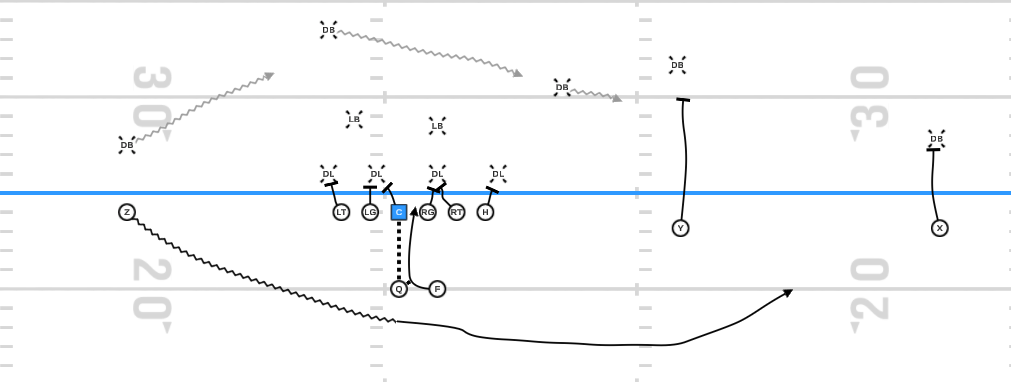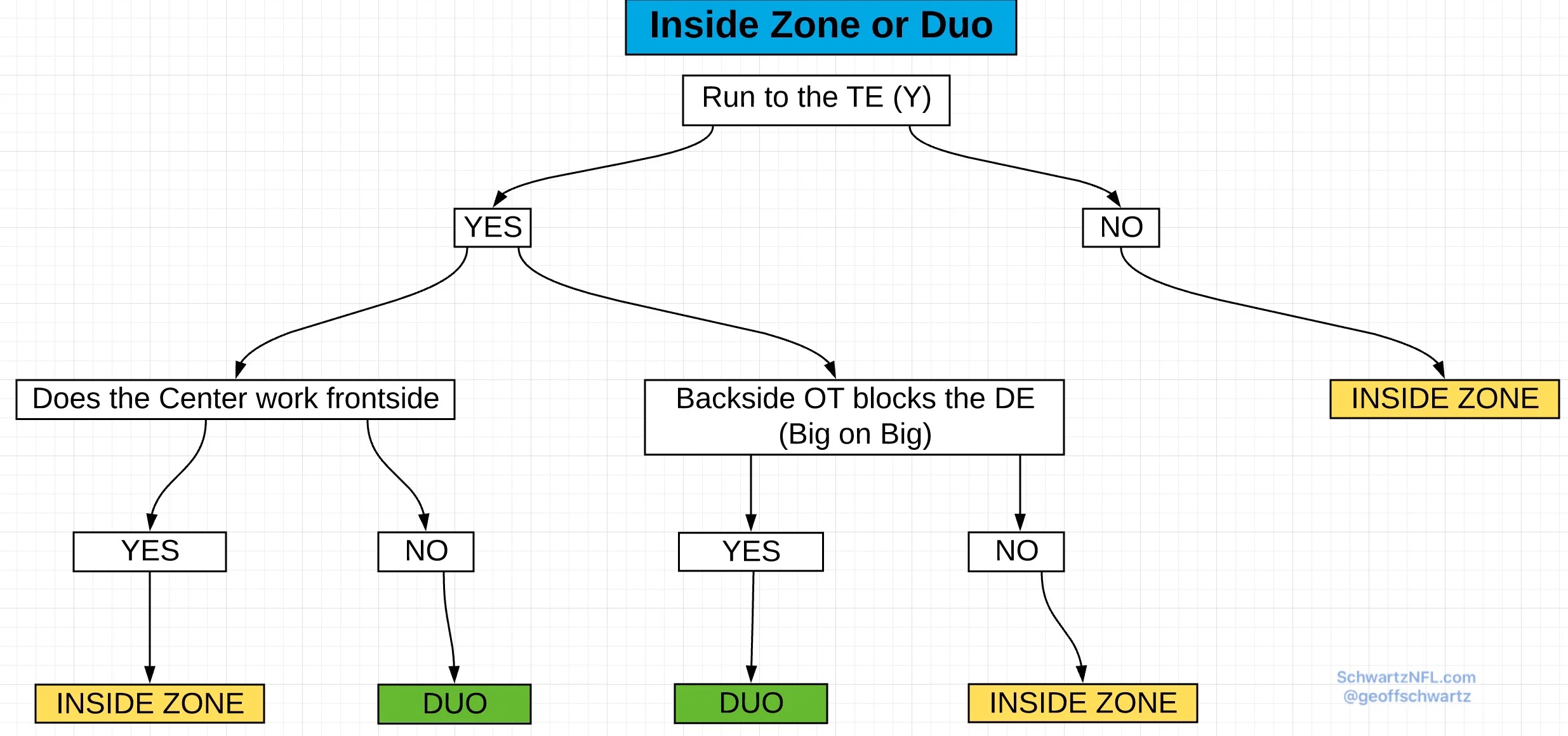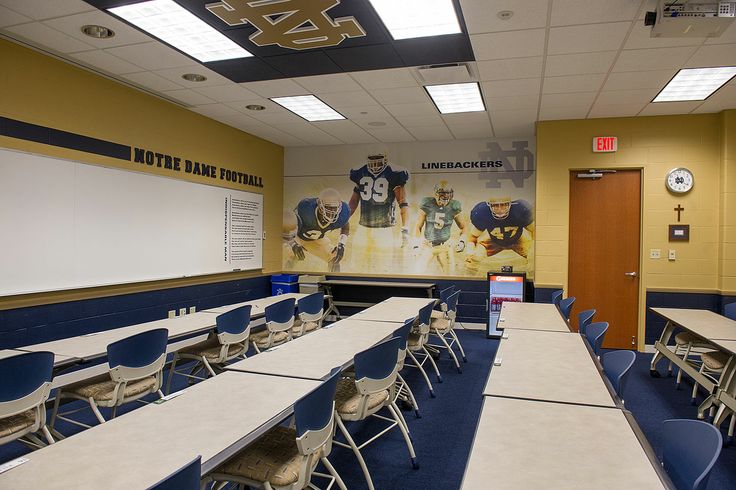Have you ever looked at a snap and wondered why it was such a success or failure? In this series I hope to try to explain and give names to the common plays that a Notre Dame Tv (or Peacock I suppose) broadcast can easily decode. Let’s first start with the most common runs that target the inside of the box.
If you want to skip the explanation and see some/all of the offensive snaps from the 2023 Blue & Gold Game.
Inside Zone
By far the most common are the various flavors of Inside Zone. Inside Zone, as its name explicitly states is a zone running style play. Basically zone blocking schemes tell the Offensive Linemen that they are responsible for an area. If they are “covered” (have a defender lined up from them) they block that defender. Else, if they are “uncovered” they block the next person in their area, typically with a double team. If the play was Inside Zone, the Offensive Linemen seek to control a more vertical area. On the other hand if the play is Outside Zone the linemen try to create horizontal control. There are several common variations of Inside Zone, one such is the Split Zone. Inside Zone plays can incorporate Quarterback reads (leaving one/several defender(s) unblocked but making them wrong every time) of various players (Possibly a first, second, or third level defender ).

Inside Zone Cutups
Firstly, here are some compiled Inside Zone, Split Zone, and Bluff plays from the Blue & Gold game.
Good Inside Zone
In the first Inside Zone cut-up, the covered linemen on the weak side block their covering defender. The Center and Right Guard combo block the Defensive End before the Center moves onto the weakside Linebacker. Likewise the Tight End and Right Tackle combo block the Defensive End before the Right Tackle moves onto the second level. All of the blockers achieve a fantastic push and the Running Back reads the blocks well for a nice gain.
Less Good Inside Zone
In the second cut-up, the Gold team is pounding at the door to score. The Blue team has 6 in the box versus Gold’s 6 blockers. I’m not sure if there was confusion in the blocking scheme, but the run is ran toward the field side, and the Gold team, through (#76 Joe Alt) leaves the playside Defensive End (#45 Kobi Onyiuke) unblocked. The Left Guard (#74 Billy Schrauth) and Center (#52 Zeke Correll) achieve excellent movement with a double team on the Defensive Tackle. The Right Guard (#50 Rocco Spindler) holds his own in a lone block, although he doesn’t achieve much movement. The Right Tackle (#59 Aamil Wagner) and (#38 Davis Sherwood) double team the boundary-side Defensive End. What made this play not a disaster was the Running Back’s (#13 Gi’Bran Payne) great effort and motor in order to get a couple yards.
Duo
Duo is a gap scheme inside run focused on achieving double team’s at the point of attack. The name comes from creating (at least) two double teams on the line of scrimmage. Duo is typically explained as “Power without a puller”, although Notre Dame only used power blocking once during the 2023 Blue & Gold Game.
Duo is almost always ran toward the inline Tight End side. The blocking scheme for Duo can be described as the following: Playside TE: Block the playside End-Man-Line-Of-Scrimmage (EMLOS) Offensive Line: check backside gap, if it is filled down block that player. If it is unfilled double team play-side. The center ID’s the backside linebacker as who he block toward after getting off the double team.
With Duo, the Running Back is running in the opposite flow of the Offensive Line: for example the Offensive Line blocks to the right and the Running Back attacks to the left. This is opposed to Inside Zone where the Running Back is going to the flow of the Offensive Line. In this way, Duo and Inside Zone compliment each other very well. In both Duo and Inside Zone, the Running Back is not given a single track that they need to run. The Running Back either reads the key defenders (typically linebackers) or flow of the defense and makes a decision to make the Offensive Line and Gerad Parker right.

Duo cutups from 2023 Blue & Gold Game.
One problem with Duo is that it relies on the Tight End making blocks directly on the defensive end. The defensive ends are sometimes game wreckers that make even decent Tight Ends look foolish in the blocking game.
One may think (and I am certainly one of them) that Duo looks rather similar to Inside Zone. Well, an 8 year NFL veteran Offensive Lineman created a helpful chart for fans to understand which play it is.
Duo Cutup
In this clip, the Gold team achieves double teams at the point of attack on both Defensive Ends. The Tight End makes a solid-enough block on the Defensive End and the boundary-side Tackle hold his own versus the boundary-side Linebacker. The running back reads his blocks well and produces a nice first down gain.
Protection
What are some ways to protect Duo and Inside Zone from defensive cheating? One way that Notre Dame uses is to create a run/pass threat to the conflict defenders through use of the Run Pass Option (RPO). Notre Dame is able to run RPO’s off both Duo and Inside Zone.
Inside Zone Triple RPO
In this clip, the Gold team is utilizing a zone blocking scheme with 6 potential blocking players versus 6 box defenders. Just to start out, these numbers are awfully favorable to the offense. When the number of blockers and box defenders are equal, the offense doesn’t need to “block” anyone by Sam reading anyone. This play had 3 options, either the defense allows the running back to run with favorable numbers, or the defense allows the Quarterback (#10 Sam Hartman) to run for a nice gain, or the defense is out-leveraged by the Tight End’s (#38 Davis Sherwood) arrow route. Anyways, in this play the Gold team sends Davis on a arrow/flat route. The boundary-side defensive end is left unblocked. The playside defensive end crashes and is “made wrong” by Sam pulling the ball. The Wide Receiver blocks the Cornerback and Mr. Hartman dumps the ball off to Davis for a nice game.
Duo Slant RPO
In this play, the Blue team runs a Duo blocking scheme with a playside quick-game concept of Slant/Curl. The Gold team has 7 defenders in the box versus 6 blockers, therefore to equalize the numbers, the Blue team will have to read some defender by the Quarterback (#12 Tyler Buchner). After the ball is snapped, the playside linebacker cheats into the box causing his safety to have no chance with the leverage he had to cover the slant. The Tyler throws to the slant for a nice gain by Wide Receiver (#2 Chris Tyree).
Further reading material:
http://breakdownsports.blogspot.com/2014/12/football-fundamentals-zone-blocking.html
https://www.reddit.com/r/nfl/comments/go1qg4/xs_and_osinside_zone_or_duo_how_to_identify_the/
https://alexbyrne.substack.com/p/duo
https://mgoblog.com/content/what-duo
https://weeklyspiral.com/2021/05/10/duo-concept/
Hello all, I used to write for 18Stripes back in 2016-2017 but stopped soon after due to personal reasons. I’m getting the itch to write again and 18S has graciously allowed me back into the fold. I used to (and plan on this season to) make condensed videos of every offensive snap. I’m playing around with some new technology so please bear with me.





Love this series! It’s what first got me on to 18s as my go to ND information source, I remember reading an article regarding chip longs pin and pull run series, glad you’re back!
With regards to more information on the x’s and o’s of the run game, the link here is awesome!
https://weeklyspiral.com/category/coaching-concepts/run-game/
Duo is very common now in that it creates a play side 2 way go for the RB; if the play side LB commits one way or the other, its designed for the back to cut the opposite, which is rad. Inside zone is basically your hands down lineman and a TE performing 3 double teams to bounces, with a way to account for the backside DE i.e. boot fake, RPO, HB cross slam block, etc.
Anywho, super cool to see this series back, you’ve definitely found a kindred schematic spirit!
Thank you for the kind words, glad that you enjoyed my previous posts! Weekly spiral is absolutely awesome. Thank you for the explanation of the running back cuts, that explains even more how duo and inside zone compliment each other.
Glad to have you back. I really like the analyzing of plays, etc.
From what I hear of last nights practice, the guard situation is far from settled.
That’s been tremendously weird all camp long.
Sounds like Spindler has taken over at right guard but that left guard is still open.